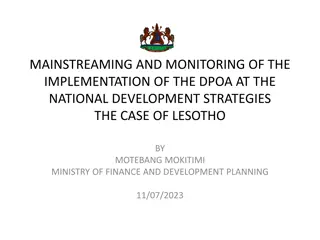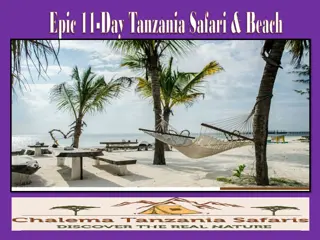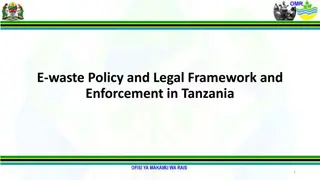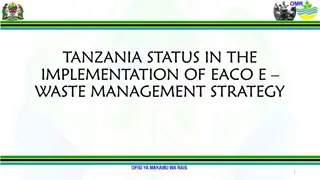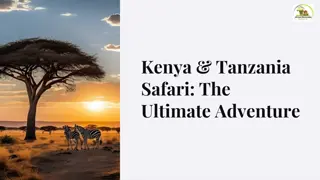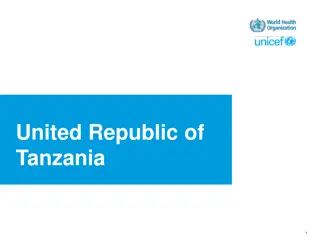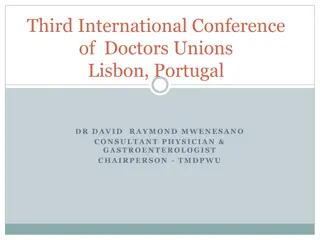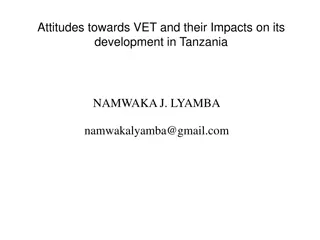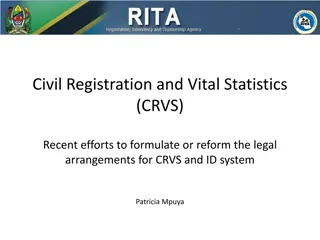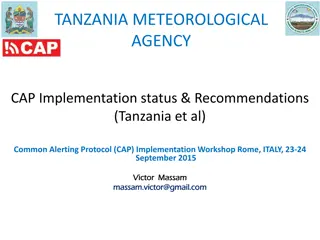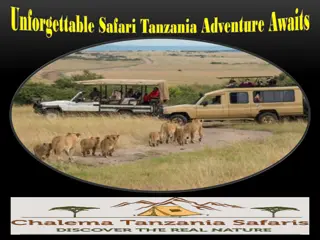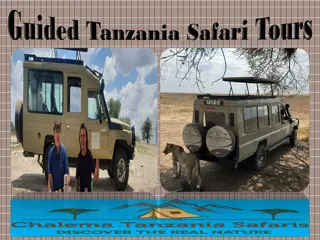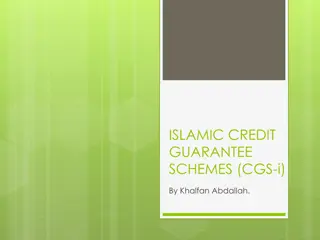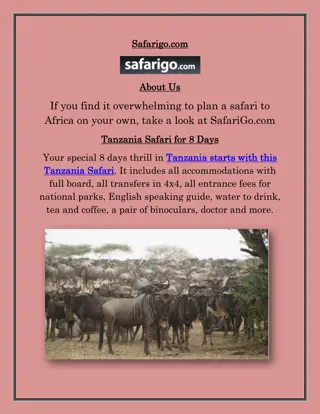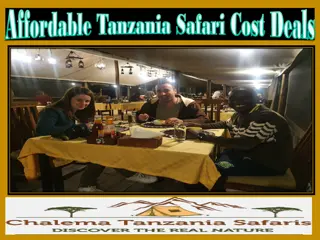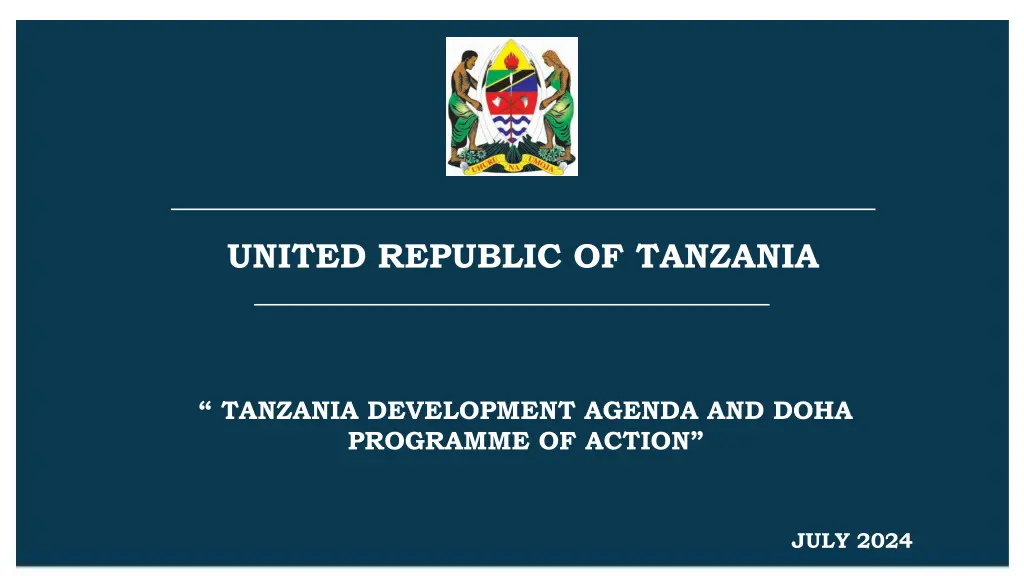
Tanzania Development Vision 2025 and Future Plans
Explore the Tanzania Development Vision 2025 (TDV 2025) and the ongoing Five-Year Development Plans, including FYDP I, FYDP II, and FYDP III, aimed at transforming Tanzania from a least developed to a middle-income country by 2025. Learn about the key themes, aspirations, and strategies driving the country's economic development agenda.
Uploaded on | 0 Views
Download Presentation

Please find below an Image/Link to download the presentation.
The content on the website is provided AS IS for your information and personal use only. It may not be sold, licensed, or shared on other websites without obtaining consent from the author. If you encounter any issues during the download, it is possible that the publisher has removed the file from their server.
You are allowed to download the files provided on this website for personal or commercial use, subject to the condition that they are used lawfully. All files are the property of their respective owners.
The content on the website is provided AS IS for your information and personal use only. It may not be sold, licensed, or shared on other websites without obtaining consent from the author.
E N D
Presentation Transcript
UNITED REPUBLIC OF TANZANIA TANZANIA DEVELOPMENT AGENDA AND DOHA PROGRAMME OF ACTION JULY 2024
01 01 Introduction Introduction o Tanzania Tanzania Development o FYDP FYDP III III Development Aspirations Aspirations 02 02 DPoA and Tanzania Development DPoA and Tanzania Development o Linkages Linkages o Implementation trajectory Implementation trajectory 03 03 Outcomes Outcomes 04 04 M&E M&E 05 05 Conclusion Conclusion
The The FYDP FYDP III of of the the TDV goal goal of of reaching reaching of III is is a a continuation continuation of TDV 2025 2025 aimed aimed at of middle of the the implementation implementation at accelerating accelerating the middle- -income income status status by the country s country s by 2025 2025 01 Introduction 01 Introduction Tanzania Development Vision 2025 National Five Year Development Plans The development process in Tanzania is guided by TVD 2025 that envisioned the country to graduate from least developed to a middle-income country by 2025. FYDP I (2011/12 - 2015/16) themed Unleashing Country s Growth Potential was the first five-year plan to be implemented o Addressed the main constraints to Tanzania s growth Infrastructure; and o Human capital and skills development. TDV 2025 aspires to have a transformed economy from low productive agriculture to semi industrialized economy with five main attribute: FYDP II (2016/17 - 2020/21) themed Nurturing Industrialization for Economic Transformation and Human Development is the second five-year plan to be implemented o Promotion of growth and industrialization for economic transformation (i) High quality livelihood; (ii) Peace, stability and unity; (iii) Good governance; (iv) A well educated and learning society; and (v) A competitive economy capable of producing sustainable growth and shared benefits. FYDP III 2021/22 to 2025/26 is the final medium- term plan with theme Realizing Competitiveness- and Industrialisation for Human Development From 2009/10 development review the prepared a 15-year Strategic that was to be implemented in three phases of the five years to accelerate the implementation of the Vision.
Tanzania Development Vision 2025 National Five Year Development Plans The development process in Tanzania is guided by TVD 2025 that envisioned the country to graduate from least developed to a middle-income country by 2025. FYDP I (2011/12 - 2015/16) themed Unleashing Country s Growth Potential was the first five-year plan to be implemented o Addressed the main constraints to Tanzania s growth Infrastructure; and o Human capital and skills development. TDV 2025 aspires to have a transformed economy from low productive agriculture to semi industrialized economy with five main attribute: FYDP II (2016/17 - 2020/21) themed Nurturing Industrialization for Economic Transformation and Human Development is the second five-year plan to be implemented o Promotion of growth and industrialization for economic transformation (i) High quality livelihood; (ii) Peace, stability and unity; (iii) Good governance; (iv) A well educated and learning society; and (v) A competitive economy capable of producing sustainable growth and shared benefits. FYDP III 2021/22 to 2025/26 is the final medium- term plan with theme Realizing Competitiveness- and Industrialisation for Human Development From 2009/10 development review the prepared a 15-year Strategic that was to be implemented in three phases of the five years to accelerate the implementation of the Vision.
The FYDP III priority areas A. Creating a Competitive Economy Enabling Doing Business Environment; Market Organisation and Coordination; and Digital Revolution. B. Deepening Industrialisation and Service Provision Manufacturing industry; Agro-processing, Value Addition and mining; Services (insurance, tourism, trade, logistics, Financial) C. Fostering Trade Growth Strengthening Regional Trade; Effective Participant in Global Trade; and Consolidating Domestic trade Realising Competitiveness and Industralisation for Human Development FYDP III D. Human Development For Industrialization requirements; and For country s to absorb and enjoy the fruits of successful industrialisation processes. E. Human Capital Development From the early levels of schooling; Technical and vocational education and training (TVET) Flagship projects are deemed critical on the basis of their large positive multiplier effects to the rest of the economy.
Flagship Projects 1. Construction of Julius Nyerere Hydropower Project (JNHPP) Current Status In general, construction is at final stage and some power plant started operation. JNHPP will have a total installed capacity of 2,115MW Annual power generation 6,307GWh The normal operation level of the reservoir, NLO, is 184.0m.a.s.l 2. Revamping of the ATCL Purchased 15 new and modern aircrafts; ATCL Government is 100% owned by the Operating in 16 domestic routes and six (6) international. Aircrafts Government Flight Agency (TGFA) and are leased to ATCL are owned by Tanzania 3.Construction of Standard Gauge Railway on Central Railway Line Construction for Lot I & II completed; The 2,561 km project Total project cost USD 7.6 billion Train speed up to 160km/h for coaches and 120 km /hr for wagons The project has 7 lots to be constructed Lot III VII construction underway
The resource envelope for the FYDP III 114.9 Trillion Shillings i. Domestic public revenues provide the bulk of financing for development, with the traditional sources still being: taxes non-tax revenue; and LGA own sources. Domestic Financing of FYDP III Public Sector: TZS 74.3 Trillion Private Sector: TZS 40.6 External Grants 6.7% increase from FYDP II; ii. Other FYDP III financing sources External Grants External Borrowing Domestic Borrowing Climate Change Fund Public Private participation 17.8% increase from Government budget 107 Trillion estimated from FYDP II 7
FYDP III Implementation Strategy (IS) The Action Plan for implementation of FYDP III: Outlines the necessary actions to be taken to realize the intended objectives and targets of the plan to foster implementation. 1 Financing Strategy: identifying possible sources of financing the plan and addressing challenges of implementation financing for projects and its mitigations 2 Monitoring and Evaluation Strategy: outlining how best monitoring and evaluation for the plan implementation, set performance indicators and how best to measure them in line with National Project Monitoring Information system (NPMIS). 3 8
2. Doha Programme of Action and Tanzania Development Aspirations
DPoA in Tanzania Context The Government of the United Republic of Tanzania as a member state of LDCs continue to implement DPoA in priority areas of investment in human capital; ICT; enhancement of international trade; addressing the climate crisis through our long-term, medium and short-term plans considering the context and priorities outlined in the Development Visions.
Mainstraming DPoA into NP Mainstraming DPoA into NP Investing in people in LDCs: Eradicating Poverty and Building Capacity to Leave No One Behind Human Development > Implements projects that focus on improving people's lives such as education and training; health; social protection; water and sanitation services. Climate change, recovering from the COVID-19 pandemic, and building resilience against future shocks for risk-informed sustainable development Human Development > Project for adaptation and mitigation on the impact of climate change. Enhancing International trade of least developed countries and regional integration - Deepening Industrialization > Focus on value addition on agricultural, livestock, and fisheries products, minerals. Supporting structural transformation as a driver of prosperity Realizing inclusive and competitive economy > Fostering macroeconomic stability; strengthening the investment and trade environment; promoting innovation.
Outcome of these Initiatives Outcome of these Initiatives Human Development Index increases from 0.41 in 2002 to 0.549 index in 2022; On health the country lowered matertenal mortality from from 220 deaths in 2015 to 104 for every 100,000 live births in 2021; Fee-free basic and secondary education, enrollment rate at primary level is now above 95 percent ; Increased financial inclusion in turn enabled Medium, Small and Micro Enterprises (MSMEs) to contribute more towards Global development agenda; and Economy continue to grow at a pace of 5.1 percent in 2022 compared to 4.7 in 2021;
Monitoring and Evaluation of FYDP III The Plan is monitored using the Monitoring and Evaluation Strategy (MES). The Strategy outline how best monitoring and evaluation for the plan implementation. Set performance indicators and how best to measure them in line with National Project Monitoring Information system (NPMIS). Weakness Inadequate data to monitor some indicators. Limited budget for financing development plans and monitoring of interventions.

